Hitachi vs. Western Digital vs. Seagate: A Battle of the Mammoths
by Purav Sanghani on December 2, 2005 12:05 AM EST- Posted in
- Storage
HDTach - Sequential Read Speed/Burst Speed
The HDTach benchmark gives us a great deal of detail on the performance of a hard drive. Like the WinBench 99 Transfer Rate test, HDTach graphs the sequential read speed of the drive as the drive reads continuously from beginning to end.
Seagate 500GB 7200.9
Hitachi 7K500
Western Digital WD4000YR
The 500GB 7200.9 redeems itself here with the highest burst speed of 248.1MB/sec with the 7K500 coming in second at 223.6MB/sec. The rest of the figures here are all over the board with the 7K500 holding the lowest random access time at 12.6ms and the WD4000YR having the highest average read rate of 56.9MB/sec. We are obviously not ready to call a winner after only a few tests.
Windows Read Speed Test
Seagate 500GB 7200.9
Hitachi 7K500
Western Digital WD4000YR
The HDTach benchmark gives us a great deal of detail on the performance of a hard drive. Like the WinBench 99 Transfer Rate test, HDTach graphs the sequential read speed of the drive as the drive reads continuously from beginning to end.
Windows Read Speed Test
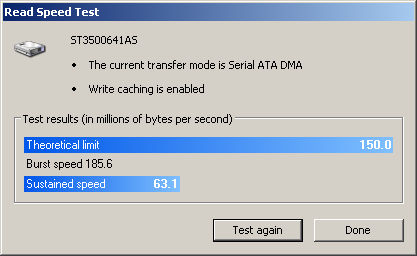
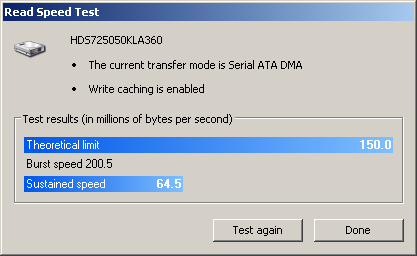
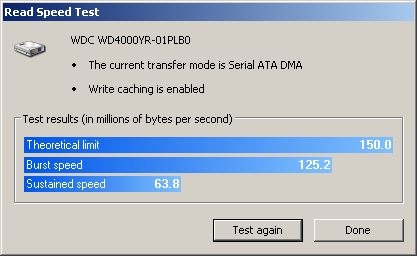
It seems the Windows Read Speed Test gives us a better readout of the actual transfer rates of each drive. We see that the Seagate and Hitachi read speeds are off the charts because of their 3.0Gb/sec maximum transfer rate. The WD4000YR is a 1.5Gb/sec drive which is why the transfer rate is much lower than the 7K500's 200MB/sec+ rate.


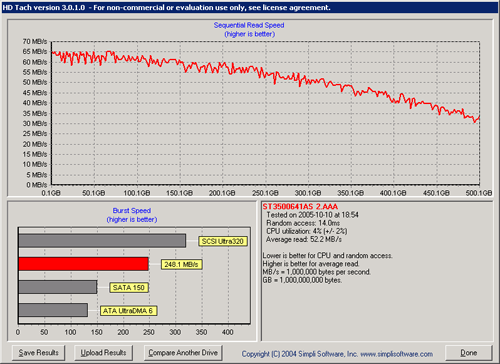
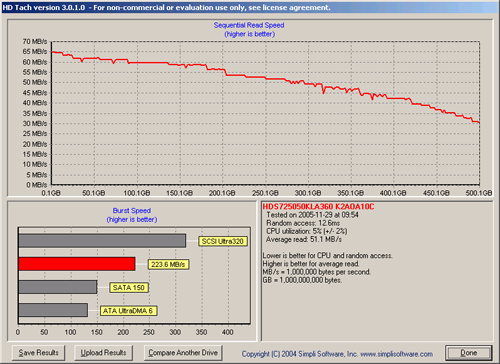
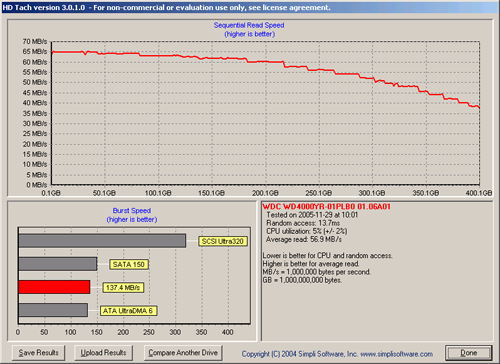








46 Comments
View All Comments
mostlyprudent - Friday, December 2, 2005 - link
AT, your multitasking conclusion is interesting. You give the nod to the WD drive because it has the smallest percentage performance drop when running the multitasking scenario. However, the Seagate drive was faster in both the Zip only test and the multitasking test. Theoretically, it slowed down more when moving to the multitasking scenario, but in reality was still faster than the WD. I understand conceptually that you're looking at the effect that multitasking has on drive performance, but I wonder if this is a relevant test when comparing drives.Anton74 - Friday, December 2, 2005 - link
This may be slightly off topic, but for me personally (and I think a lot of folks), it'd be much more interesting to see reviews of drives that I might actually buy, which are at the moment 300GB or less - these larger drives are just too expensive per GB.I'd be particularly interested in the 160GB 7200.9, which to my knowledge still hasn't been tested by anyone - and it's the drive with the highest platter density at the moment, by far! But there are at least a handful reviews of the 500GB version already (which was praised with "mouthwatering benchmarks" a good month ago, but now "is just not up to par to recommend"...).
While I'm at it, how are the (mostly) slower 3Gb/s SATA drives more "future-proof"? If they're slower than the WD today despite their faster interface, they'll be slower than the WD 2 years from now, me thinks. Or are they expected to improve with age? :-P
Don't get me wrong here though, I'm glad you guys are spreading all this review goodness around (you were the first to review the Asus A8N-VM CSM for example, two thumbs up).
bob661 - Friday, December 2, 2005 - link
Too expensive?! LOL! How cheap do you want them to be? Hard drives are DAMN cheap now. One of the cheapest components of the computer.LoneWolf15 - Friday, December 2, 2005 - link
What he means is, that buying a 250GB drive is FAR cheaper on a cost-per-gigabyte basis. As drive size increases past a certain point in the current market, vendors charge more per GB. When you think about the fact that a Hitachi 250GB SATA2 hard disk is currently around $110, and a 500GB model is $395, why in the world would you buy the larger drive when two 250GB models cost so much less? Most of us enthusiasts have the case space, and if you really want a single large partition that badly, you can use Win2k/XP's Dynamic Drive capabilities or the JBOD feature of your RAID controller (note: I wouldn't do this personally due to data integrity issues if one drive fails, I'd just have two partitions).
He's not whinging that hard disks are expensive; just that there's no point in buying a pricey large HDD, when two medium HDD's that amount to the same size can be had for a lot less.
yacoub - Friday, December 2, 2005 - link
Expect few here to understand your point. Many people here just want dick measurements of the largest, fastest pieces of hardware with as few real world constraints as possible. It makes no sense for the consumer but it makes more entertaining reading and they're here for entertainment not research purposes. :[bob661 - Friday, December 2, 2005 - link
Makes perfect sense to me and, apparently, a lot of other folks here. I don't think it's out of line at all to test these drives. We ARE enthusiasts here and quite a number of us can afford enthusiast budget systems. If you want J6P reviews go over to PCWorld or something. Granted I'm not in the 7800GTX 512MB crowd (I'm a bang for the buck guy), but I DO like to see these things get reviewed. "I" like to know what's out there.Cygni - Friday, December 2, 2005 - link
Anandtech can only test what the companies send them... which is why you only see reviews of high end parts or parts with special features. Makes things difficult because they could obviously make much more comprehensive and equal comparisons if they got to pick and choose... but thats life.Questar - Friday, December 2, 2005 - link
No.Anandtech *chooses* to only test what companies send them. There is nothing preventing them from ording drives for testing.
PuravSanghani - Friday, December 2, 2005 - link
We actually purchased the 500GB 7200.9 the week it was released so that we could benchmark these drives as quickly as possible to let our readers know how it performed before they went ahead and bought it for themselves. We thought that since it was Seagate's highest capacity drive to date and targeted towards servers it would be very informative to those who were looking for high capacity drives.This 3-way comparison was written up to show the differences between the highest capacity drives from 3 of the top hard drive manufacturers in the world to help our readers looking for high capacity models to choose the product that best fits their needs.
Regards,
Purav
Visual - Friday, December 2, 2005 - link
Nah, for products that are already available retail, it was never a problem for AT to buy their own samples. In fact, it's the preferred way, as the companies can't hand-pick better oc-ers or such. This always was one of the pluses of this site.